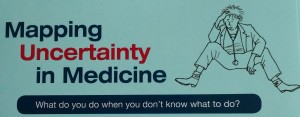In one of Liam Farrell’s typically hilarious blogs, he relates the painful task of explaining that an elderly relative, instead of dying as expected, has perked up and is enjoying the company of her extended family who have flown in from their far flung lives across the world …expecting a death. (https://drliamfarrell.wordpress.com/2017/05/09/breaking-good-news-in-a-bad-way/). The family are not best pleased that their well laid life plans had been interrupted by the false expectation of grannies death. After all they all had other things going on!
This got me thinking about why and how breaking good news and be just as hard as breaking bad news and sometimes gets us into clinical WDYDWYDKWTD moments.
Bad news means something that changes your view of the future for the worse; we easily recognise how a cancer diagnosis an abnormal smear or even an allergy could do that, But good news? Surely everyone is keen on that? As Dr Farrell discovered it all depends on the context and the way you tell it.
Doctors often keep their clinical reasoning thoughts to themselves; this can result in seriously crossed lines of communication with the patient. The doctor does a blood test to rule out anaemia and is relieved when the tests is normal. The patient hopes that the test will rule something in and is disappointed when the result is normal, perhaps saying, “so you still do not know what is wrong with me?” The clinicians good news is the patient’s bad news.
This conversation can put the clinician on the back foot making them feel uncertain about what to do next; jumping to a dysfunctional way out of uncertainty can lead to a reflex referral for “a few more tests”. Before long, a cascade of normal investigations follows, having the paradoxical effect of good news leading to increasing rather than decreasing anxiety in both clinician and patient. The search for a test result or radiological image that will define the problem can be a fruitless one, as many conditions in General Practice will inevitably remain poorly defined, purely symptomatic, or be at such an early stage that tests can be normal.
If testing creates an expectation that a diagnosis is there somewhere “waiting to be found” the patient will be harmed because investigation takes the place of treatment and care. Moreover, repeated testing in such a context is in effect evidence free screening, or fishing, for poorly defined purposes. The more tests done, the more likely one will be slightly abnormal; resolving this can lead to further tests or investigations accompanied by increasing anxiety and delays to active symptomatic treatments. However, the dysfunctional way out of an uncertain situation by doing more tests can be avoided if the need for breaking good news is anticipated and planned for.
The skills of “Breaking Good News” are like the skills of “Breaking Bad News”; the application of generalist listening and consultation skills to the particular task of explaining and planning care. Before any tests or investigations are done the doctor needs to be clear about their purpose; rule in or rule out? (something common serious or treatable usually). It is best to avoid the dysfunctional testing whose purpose is “get this patient out of here”. The potential for normal results should be explained to the patient before tests are done, and the possible subsequent actions should be on the table at the beginning.
For example, in a patient with mild fatigue, normal examination and no red flags it could go like this;
“ Well, the good news is that your story and physical examination are reassuring , so in the first place we can hope that things will improve with time and if you get more regular sleep, a daily walk and avoid alcohol. Come back in a month if things not settling down”
( see http://www.racgp.org.au/afp/2014/july/fatigue/ and https://www.ncbi.nlm.nih.gov/pmc/articles/PMC2662125)
It is all in the framing; not “I don’t know what is wrong”, rather “it’s good you seem to be healthy currently… let’s concentrate on what we might help”. In the longer run, positivity, combined with robust safety netting, is less likely to result in disillusionment.
In summary, when Breaking GOOD news…plan ahead, signal that good news is coming, empathise with the impact that the news is having, use positive language like “ healthy, normal” or “great for your age” and interpret any findings in the light of the patients own concerns. These approaches will naturally lead into plans that relate to the patient’s own specific needs. Always aim for a dialogue, so that your conversation develops guided by your expertise applied to the patients concerns. So, something to try in a consultation…BGN (Breaking Bad news) and sharing uncertainty with patients in a useful way. Perhaps these ideas might make it on to a Personal Development Plan near you!
Could this approach would have helped poor Dr Farrell?

